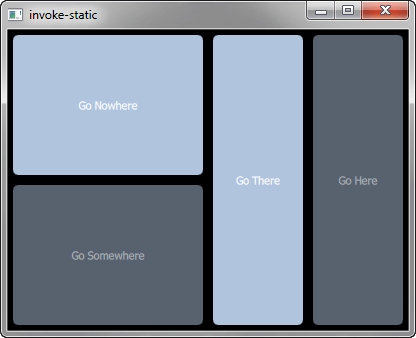
Invokes a compiled nested state machine.

Invoke demonstrates how to use the <invoke> element with generated nested state-machines, where the SCXML file is compiled to a C++ class. The <invoke> element is used to create an instance of an external service.
To run the example from Qt Creator, open the Welcome mode and select the example from Examples. For more information, see Qt Creator: Tutorial: Build and run.
In statemachine.scxml, we specify a state machine with the name DirectionsStateMachine of type http://www.w3.org/TR/scxml/ to invoke:
<scxml
xmlns="http://www.w3.org/2005/07/scxml"
version="1.0"
name="DirectionsStateMachine"
initial="anyplace"
>
<state id="anyplace">
<transition event="goNowhere" target="nowhere"/>
<transition event="goSomewhere" target="somewhere"/>
<state id="nowhere"/>
<state id="somewhere">
<invoke type="http://www.w3.org/TR/scxml/">
<content>
<scxml name="anywhere" version="1.0">
<state id="here">
<transition event="goThere" target="there"/>
</state>
<state id="there">
<transition event="goHere" target="here"/>
</state>
</scxml>
</content>
</invoke>
</state>
</state>
</scxml>
We link against the Qt SCXML module by adding the following lines to the example's build files.
QT += qml scxml
We then specify the state machine to compile:
STATECHARTS = statemachine.scxml
find_package(Qt6 REQUIRED COMPONENTS Core Gui Qml Scxml)
target_link_libraries(invoke PRIVATE
Qt6::Core
Qt6::Gui
Qt6::Qml
Qt6::Scxml
)
We then specify the state machine to compile:
qt6_add_statecharts(invoke
statemachine.scxml
)
The statechart directives STATECHARTS or qt6_add_statecharts invoke the Qt SCXML Compiler, qscxmlc, which is run automatically to generate statemachine.h and
statemachine.cpp, which are then added appropriately as headers and sources for compilation.
The state machine is declared as a QML element as follows:
struct DirectionsStateMachineRegistration { Q_GADGET QML_FOREIGN(DirectionsStateMachine) QML_NAMED_ELEMENT(DirectionsStateMachine) QML_ADDED_IN_VERSION(1, 0) };
We instantiate the generated DirectionsStateMachine element in the MainView.qml file, as follows:
DirectionsStateMachine { id: stateMachine running: true }

As part of the free Business evaluation, we offer a free welcome call for companies, to talk about your requirements, and how the Felgo SDK & Services can help you. Just sign up and schedule your call.
Sign up now to start your free Business evaluation:

